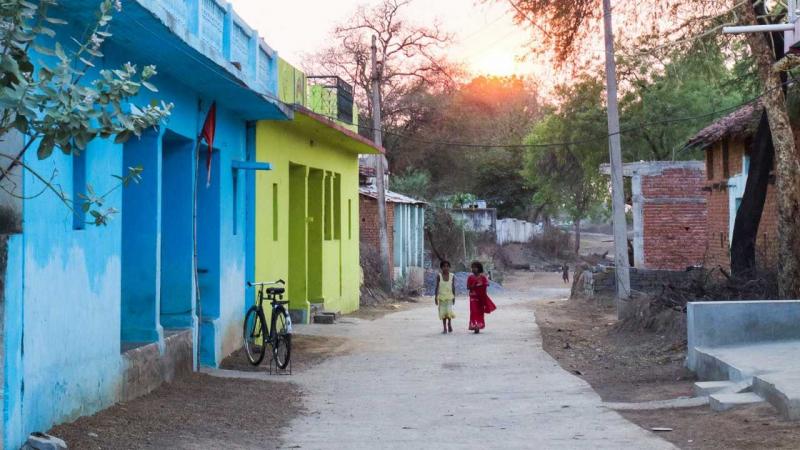
Researchers devise a model for fostering rural entrepreneurship, generating sustainable livelihoods and tackling poverty
Although India is rapidly urbanising, about 66.4% of the population still lives in rural areas. Hence, providing basic needs and livelihood opportunities for this majority is of paramount importance. Many government schemes designed to develop infrastructure and skill the rural populace to generate employment opportunities have helped decrease rural poverty from 55% in 2005-06 to 28% in 2015-16. In spite of these schemes, employment and livelihood generation objectives are only partially achieved. In a recent study, Prof Ronita Bardhan from the Indian Institute of Technology Bombay and Ramit Debnath from the University of Cambridge, have proposed a model to best utilise the available resources in an Indian village to generate self-sustaining livelihoods and achieve rural development.
The government today has about eighteen schemes—including the likes of the National Rural Livelihood Mission, Integrated Rural Development Programme, and Mahatma Gandhi National Rural Employment Guarantee Act—all of which aim to generate means of livelihood, eradicate poverty and provide jobs with minimum guaranteed wages. However, factors like fund mismanagement, unequal budget allocation among states, lack of awareness about the schemes and administrative negligence have hindered the successful implementation of these schemes.
As an alternative, self-help groups, designed to cater to the needs of rural employment with a focus on women empowerment, have been proposed to address the gaps in the government-run schemes. However, they too have been ineffective in addressing the issues of rural development. “The self-help groups have failed to achieve community-level inclusive growth mainly due to ineffective group meetings, lack of awareness and co-operation between the members, the absence of income generating activities and a small amount of savings,” say the authors of the current study.
In their study, published in the Journal of Rural Studies, the researchers studied a village in India to explore how sustainable livelihood can be generated through social entrepreneurship and the use of existing resources. They propose a model called Resource Symbiosis, which is developed using the concept of bricolage—constructing or creating something new by using combinations of resources already at hand. According to the model, the available resources are used such that both the villagers and the local government benefit through livelihood generation and village development.
The researchers developed a conceptual framework to capture data on the available resources in a village and apply bricolage. This framework is based on another study that showed how social entrepreneurship through bricolage achieved an improvement in the Human Development Index—a statistical index of life expectancy, education, income and other factors. The current study aims at village development through bricolage.
The researchers applied their model on a village called Shingnapur in Maharashtra, which has about 920 households with agriculture as the predominant occupation. They conducted surveys to gather demographic data of the population, the existing housing, water and sanitation facilities in the village, the income and livelihood of the people, land use types and entrepreneurial activities in the village. The researchers found that the village has entrepreneurial businesses, such as retail shops and public distribution systems, and small-scale industries like a milk processing unit, amla processing unit and mechanised farming. However, the villagers faced significant problems such as indoor pollution due to firewood usage, electricity thefts and irregular billing periods, open defecation, and agricultural water demand.
As a next step, the researchers mapped the available resources and livelihood options in the village, to the problems identified there to make the bricolage framework operational. The framework was conceptualised in three phases—resource mobilisation by obtaining the necessary resources from the producer, bricolage for village development and the implementation of the government schemes that function in sync with each other.
Sustainable livelihood analysis revealed that livelihood generation in the village could be operationalised in four significant ways—resolving drudgery of women and men such as scarcity of water and low income, creating market linkages for surplus production, enabling efficient resource utilisation (like establishing cold storage), and fostering current village enterprises. Self-help groups could make use of the schemes such as National Rural Livelihood Mission (NRLM) or Mahatma Gandhi National Rural Employment Guarantee Act (MGNREGA) for seed grants that would help in setting up rainwater harvesting in the village to address the water woes in agriculture. The profits from cultivation would be used for payback.
The results of the framework showed that the village could use its available resources to establish a soybean oil mill and a biogas plant that could function along with the existing milk processing unit. It could also benefit from bricolage by creating a market-based wealth generation system, where local entrepreneurs sell their produce from the amla and milk processing units in the local farmers market, produce soybean oil through existing soybean agriculture, and use the leftovers from the oil mill for biogas production, thereby achieving self-sufficiency and local empowerment.
The authors claim that their resource symbiosis model can be customised and replicated in other villages based on their socio-cultural needs. It can also support current schemes like the National Rural Livelihood Mission and Integrated Rural Development Plan by leveraging the concept of bricolage, thus enabling policymakers for a fast-paced implementation of programmes for rural development.





